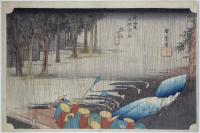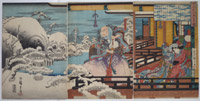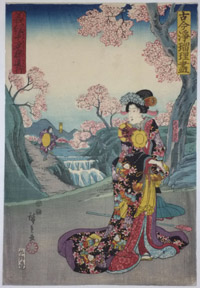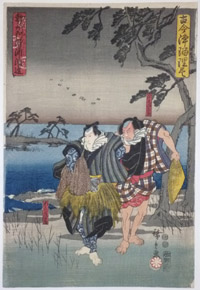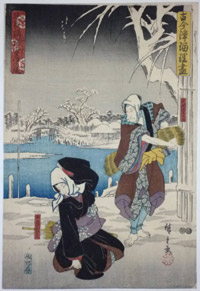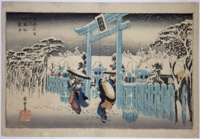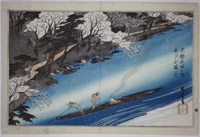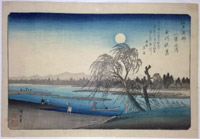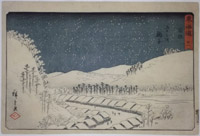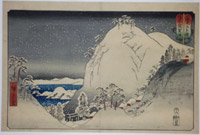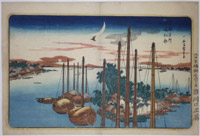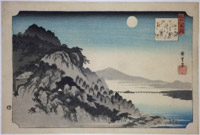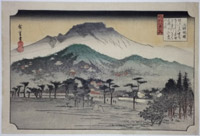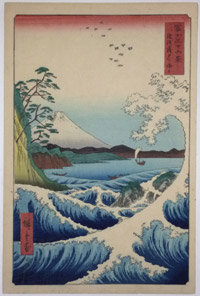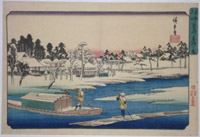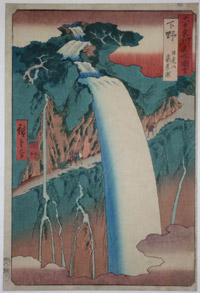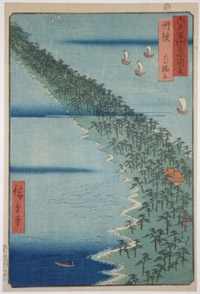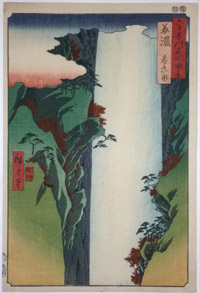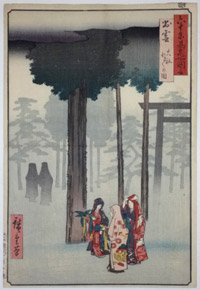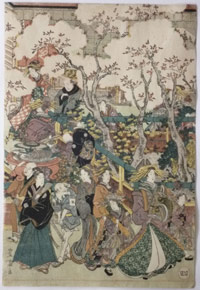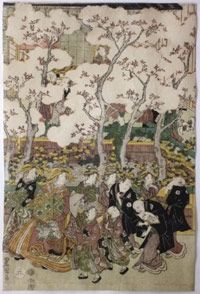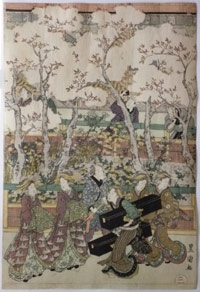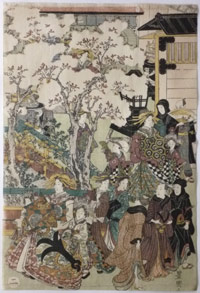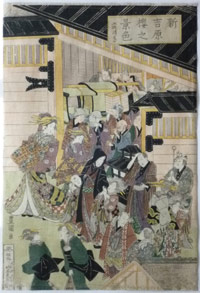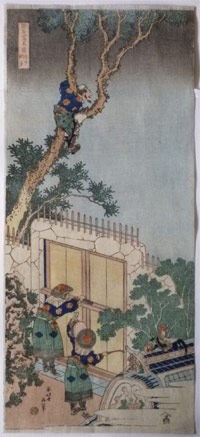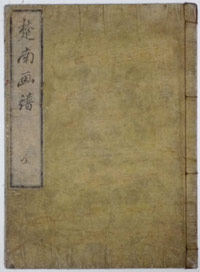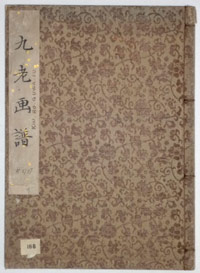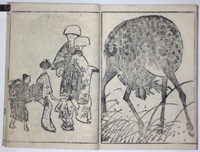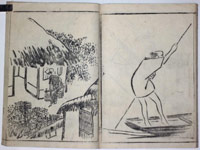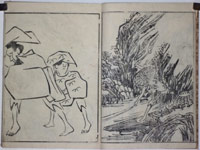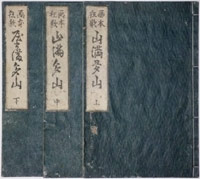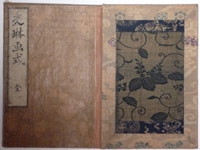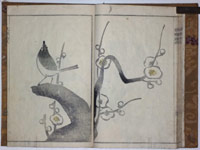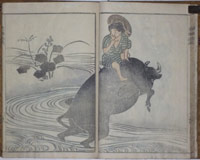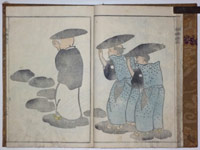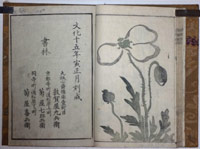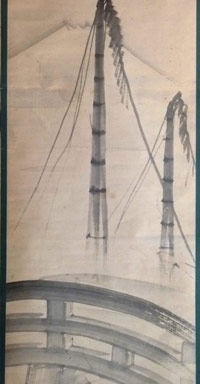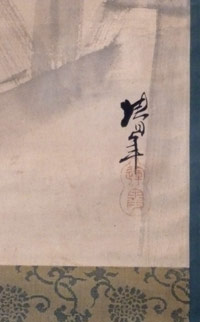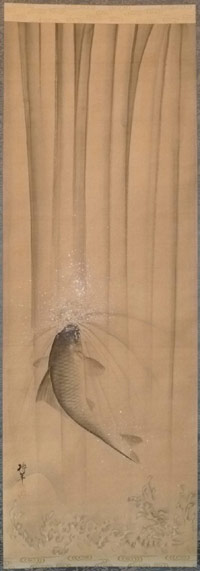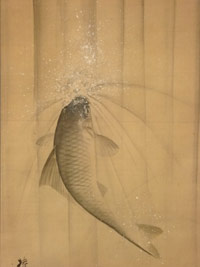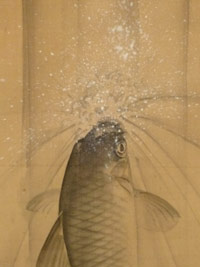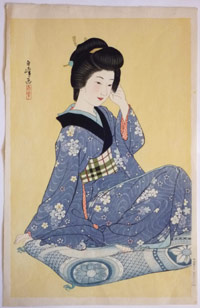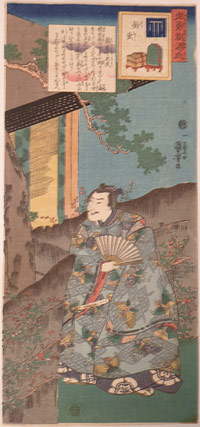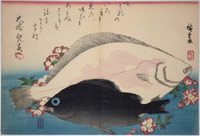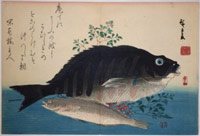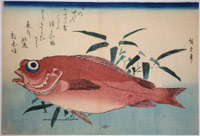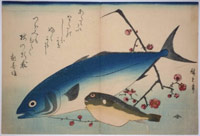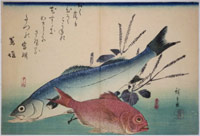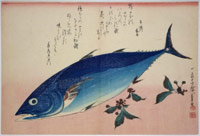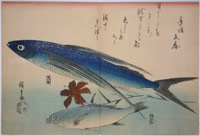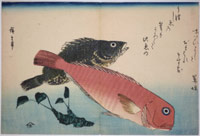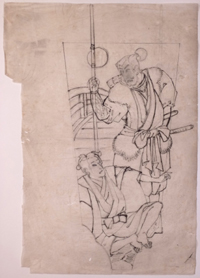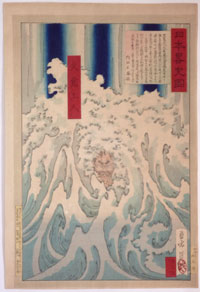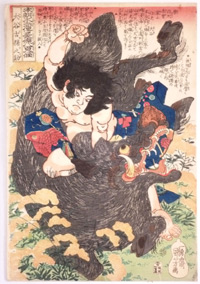/category/archive/page/32/
Ichiryusai HIROSHIGE (1797-1858)
Click here to view image full size.
Tsuchiyama haru no ame, “Spring Rain at Tsuchiyama” from Hiroshige’s most famous set: Tokaido gojusan tsugi no uchi, “The Fifty-Three Stations of the Tokaido.” The set jointly published by Takenouchi Magohachi ( Hoeido ) and Tsuruya Kiemon ( Senkakudo ), 1833-34. Shows a daimyo’s procession crossing the Tamura River in Suzuka Pass, east of Tsuchiyama. The area is famous for its green tea and infamous for the treacherous pass in winter.
Very good early impression. Imperceptible centre fold and paper flaw at bottom left edge. Very good colour. ( Interestingly, a different pigment was used for the seals on this design which oxidises to a brown colour, rather than the usual red. ) Signed Hiroshige ga.
Status: Sold
Ichiryusai HIROSHIGE (1797-1858)
Click here to view image full size.
Taira no Kiyomori kaii o miru zue, “Taira no Kiyomori Haunted by Strange Sights.” Towards the end of his life, Kiyomori, the head of the Taira clan, was obsessed with and hallucinated that his vanquished enemies had come back for retribution. Shows Kiyomori and his lover on the engawa of the palace confronted by a multitude of snow covered sculls and skeletons in the garden. Published by Kinseido, c 1845. Hiroshige’s best musha-e triptych. A much sought after and rare design.
Fine impression, colour and condition. Signed Hiroshige ga.
Status: Sold
Ichiryusai HIROSHIGE (1797-1858)
Click here to view image full size.
Yoshitsune senbon zakura, “Yoshitsune and the Thousand Cherry Trees” from an extremely rare set: Kokon joruri tsukushi, “Ancient and Modern Dramas Illustrated.” The set published c 1846 by Sanoki. Basil Stewart listed 14 known designs in his Subjects Portrayed in Japanese Colour-Prints, Kegan Paul, 1922, p. 308 and this was updated to 15 by Strange in 1925 ( which still seems to be the known number extant for this set ). Shows the fox Tadanobu and Yoshitsune’s lover Shizuka-gozen.
Very fine impression, colour and condition. Signed Hiroshige ga.
Status: Sold
Ichiryusai HIROSHIGE (1797-1858)
Click here to view image full size.
Seishu Akogi no ura. Akogi no Heiji being arrested for fishing in forbidden waters from an extremely rare set: Kokon joruri tsukushi, “Ancient and Modern Dramas Illustrated.” The set published c 1846 by Sanoki. Basil Stewart listed 14 known designs in his Subjects Portrayed in Japanese Colour-Prints, Kegan Paul, 1922, p. 308 and this was updated to 15 by Strange in 1925 ( which still seems to be the known number extant for this set ).
Very fine impression, colour and condition. Signed Hiroshige ga.
Status: Sold
Ichiryusai HIROSHIGE (1797-1858)
Click here to view image full size.
Chushin koshaku yukifuri no dan, “Meeting of the Loyal Ones in Snow” from an extremely rare set: Kokon joruri tsukushi, “Ancient and Modern Dramas Illustrated.” The set published c 1846 by Sanoki. Basil Stewart listed 14 known designs in his Subjects Portrayed in Japanese Colour-Prints, Kegan Paul, 1922, p. 308 and this was updated to 15 by Strange in 1925 ( which still seems to be the known number extant for this set ). A snow scene showing Yazama Jiutaro, one of the 47 Ronin, meeting his wife Orin in Edo after a long separation.
Very fine impression, colour and condition. Signed Hiroshige ga.
Status: Sold
Ichiryusai HIROSHIGE (1797-1858)
Click here to view image full size.
Heavy snow with geisha in front of the torii in the Gion district of Kyoto. From the set of 10 prints Kyoto meisho no uchi, “Famous Views of Kyoto.” Published by Eisendo c 1834. The first edition of this design has the publisher’s mark and kiwame seal in blue in right margin. This impression, although the second edition, is still much sought after and rare.
Very good impression and colour. Imperceptible centre fold and minor marks in margin, otherwise good condition. Signed Hiroshige ga.
Status: Sold
Ichiryusai HIROSHIGE (1797-1858)
Click here to view image full size.
Arashiyama manka, “Cherry Trees in Full Bloom at Arashiyama” from the set of 10 prints Kyoto meisho no uchi, “Famous Views of Kyoto.” Published by Eisendo c 1834. Arashiyama, to the west of Kyoto, was the place to admire the cherry blossom. Shows men poling a large raft down the Hosu River. Numerous states exist of this design: some with variant gradation on the river, others with colour variations on the far bank.
Very good impression. Slight fading. Imperceptible centre fold. Minor marks in margin, otherwise good condition. Signed Hiroshige ga.
Status: Sold
Ichiryusai HIROSHIGE (1797-1858)
Click here to view image full size.
Tamagawa no shugetsu, “Autumn Moon over the Tama River” from the early set Edo kinko hakkei, “Eight Views in the Environs of Edo.” The set was first privately printed for the Taihaido poetry club by Sanoya Kihei ( Kikakudo ) c 1837-8 with three poems on each design. For obvious reasons examples from this edition are of the utmost rarity. The set was then re-issued with one poem on each ( as here ). Even examples of these are rare. Shows dusk falling over the Tama River whose source was Mount Tanba. The river was full of freshwater trout and fishermen can be seen on the river bank. Unidentified collector’s seal bottom left.
Very good impression and colour. Tips of upper two corners repaired, otherwise very good condition. Signed Hiroshige ga.
Status: Sold
Ichiryusai HIROSHIGE (1797-1858)
Click here to view image full size.
Mariko from Tokaido gojusan tsugi, “The Fifty-three Stations of the Tokaido”. The so-called Reisho Tokaido. Published by Maruya Seijiro, c 1851-2. Although Mariko, it probably shows the mountain village of Utsunoya on the way to the next station, Okabe. In contrast to most snow scenes where the earliest states have light blue graduated skies, this is only known with a slate-grey sky.
Fine impression. Very good colour. Imperceptible centre fold, otherwise very good condition. Signed Hiroshige ga.
Status: Sold
Ichiryusai HIROSHIGE (1797-1858)
Click here to view image full size.
Bizen, Yukazan. A figureless snow scene and the best design from the set of twenty prints entitled: Sankai mitate sumo, “Mountains and Sea Contending like Wrestlers”- one of the most poetic of his titles which is in an umpire’s fan used for wrestling matches, top right. The set published and sealed Horse 7 and 8 ( 1858 ) by Yamadaya. ( Happer lists it as the previous Horse Year 1846. ) One of Hiroshige’s last designs and rare. The set is divided into ten designs of mountains and ten prints of harbours.
Very fine impression of the first edition ( variegated cartouche ). Fine colour. Imperceptible centre fold and the usual oxidation, otherwise very good condition. Signed Hiroshige ga.
Status: Sold
Ichiryusai HIROSHIGE (1797-1858)
Click here to view image full size.
Tsukudajima hatsu hototogitsu, “The First Cuckoo at Tsukudajima Island” from Hiroshige’s first major landscape set of ten prints with title Toto meisho published by Shoeido c 1831-2. Shows a few boats off the Island in the Bay of Edo as seen from Eitai Bridge. To the right the Shiba district and on the left the tip of Honju Fukugawa. This is the rare first state with ochre border, graded blue on the water, and with the publisher’s name and address in right margin.
Fine impression and colour. Imperceptible centre fold. Large margins with publisher’s name and address in right margin intact. ( It is often trimmed, eg the Pulverer impression, pl. 6, Hiroshige, Matthi Forrer, 1997. ) Very good condition. Signed Hiroshige ga.
Status: Sold
Ichiryusai HIROSHIGE (1797-1858)
Click here to view image full size.
Autumn moon at Ishiyama, Ishiyama no shugetsu, from the set of eight prints: Eight Views in Omi Province published 1834 by Hoeido. “Eight Views” was borrowed from Chinese poetry and each print conveys, pictorially, the kyoka poem written in the square label at the top right. To the left, hidden in trees, is the temple where Murasaki Shikibu ( c 978 – c 1014 ) wrote her great novel Tales of Genji. The scene shows Lake Biwa, Seta Bridge and Mount Hira on the horizon. Hiroshige probably never surpassed the ethereal, figureless quality this set possesses.
Very good impression, colour and condition with good margins. The top-left mountain always shows slippage of the blue block on this design. The set was advertised as a “work in black and white, lightly coloured” and early states have a very limited palette. Later editions of this design incorporate green and brown into the cliffs on the left. Signed Hiroshige ga.
Status: Sold
Ichiryusai HIROSHIGE (1797-1858)
Click here to view image full size.
Evening Bell at Miidera Temple, Mii no bansho, from the set: Omi hakkei no uchi, “Eight Views in Omi Province.” The series of eight prints was published by Hoeido and Eikyudo, c.1834-5. When first published it was advertised as a “work in black and white, lightly coloured,” and Hiroshige was never to surpass the ethereal quality that these figureless landscapes possess. The theme “Eight Views” was borrowed from Chinese poetry and each print conveys pictorially the poem written in the square label at the top right. Beside it, in a red label, is the series title. The designs for the set are known in various states and there are variations in colouring and gradation. Shows the temple hidden in the hills on the southern side of Lake Biwa.
Fine impression. The first edition without the break in the line-block on left next to the row of trees and the break on the lower side of the cartouche containing title. ( Both can be seen on the impression in the Honolulu Academy of Art. ) Fine colour. Minor thinning, otherwise very good condition. Signed Hiroshige ga.
Status: Sold
Ichiryusai HIROSHIGE (1797-1858)
Click here to view image full size.
A giant wave thrown up by the sea at Satta. Suruga Satta kaijo, “Waves Off the Satta Pass in Suruga Province” from the set Fuji sanjurokkei, the “Thirty-six Views of Mount Fuji.” The finest design from the set. The spume of a wave was thought to transmogrify into chidori ( a species of plover ) which can be seen here flying above the sea. Published by Tsutaya Kichizo, 1858. One of Hiroshige’s most popular prints.
Very good impression, colour and condition. Signed Hiroshige ga.
Status: Sold
Ichiryusai HIROSHIGE (1797-1858)
Click here to view image full size.
Masaki yukibare, “Clearing Weather After Snow.” A Toto meisho set of 21 prints published by Kikakudo ( Sanoki ) c 1832-5 and then extended to 55 in c 1839-42. Shows the temple on the far shore with boatmen navigating the river in the foreground. The scene under heavy snow.
Fine impression of the first edition with red Kikakudo seal in right margin ( later editions have the black seal of Sanoki ). Fine colour. Trimmed close on right side. Imperceptible centre fold, otherwise fine condition. Signed Hiroshige ga.
Status: Sold
Ichiryusai HIROSHIGE (1797-1858)
Click here to view image full size.
The Urami Falls, Mt. Nikko, Shimotsuke Province. Shimotsuke, Nikkozan urami no taki. One of the best designs from Rokuju yoshu meisho zue, “Famous Places in the Sixty-Odd Provinces.” The series published by Koshimuraya Heisuke between 7/1853 and 3/1856 ( this being 8/1853 ). The “Back-View” waterfall, so-called because it could be viewed from a path underneath.
Fine early impression with blind-printing on the water. The first edition has the falling water printed blue and other colour variations. ( See Pulverer impression in Rokujuyoshu Meisho Zue, Iwanami Shoten, Tokyo, 1996, no 27. ) However, this is one of those cases where the earliest state is not necessarily the preferred one. Fine colour. Slight edge soil, otherwise very good condition. Signed Hiroshige ga.
Status: Sold
Ichiryusai HIROSHIGE (1797-1858)
Click here to view image full size.
Amanohashidate in Tango Province. One of the best designs from Rokuju yoshu meisho zue, “Famous Places in the Sixty-Odd Provinces.” The series published by Koshimuraya Heisuke between 7/1853 and 3/1856 ( this being 12/1853 ). The sandbank extended about three kilometres into the Sea of Japan. With Miyajima and Matsushima, considered to be one of the three most beautiful spots in Japan..
Fine early impression. The first edition has variations in the clouds. ( See Pulverer impression in Rokujuyoshu Meisho Zue, Iwanami Shoten, Tokyo, 1996, no 38. ) Fine colour and condition. Signed Hiroshige ga.
Status: Sold
Ichiryusai HIROSHIGE (1797-1858)
Click here to view image full size.
The Yoro waterfall in Mino Province. Mino Yoro no taki. One of the best designs from Rokuju yoshu meisho zue, “Famous Places in the Sixty-Odd Provinces.” The series published by Koshimuraya Heisuke between 7/1853 and 3/1856 ( this being 8/1853 ). The fall was also depicted by Hokusai in his set of waterfalls.
Very fine early impression with strong woodgrain and blind-printing on the fall. The first edition has the falling water printed blue and other colour variations. ( See Pulverer impression in Rokujuyoshu Meisho Zue, Iwanami Shoten, Tokyo, 1996, no 23. ) The present state is preferred by some collectors. Fine colour and condition. Signed Hiroshige ga.
Status: Sold
Ichiryusai HIROSHIGE (1797-1858)
Click here to view image full size.
Women bringing offerings to the great shrine in Izumo, Izumo, taisha hotohoto no zue. Hotohoto was a festival on the 14th day of the first month and children went around receiving rice cakes or small amounts of money. One of the best designs from Rokuju yoshu meisho zue, “Famous Places in the Sixty-Odd Provinces.” The series published by Koshimuraya Heisuke between 7/1853 and 3/1856 ( this being 12/1853 ). Izumo is the oldest shrine in Japan in the far south-east of Honshu. The colourful foreground figures contrast with the silhouettes of others and cryptomeria trees receding into the mist.
Fine early impression with nice wiped bokashi across the foreground ( missing on later editions ). The first edition has gradation on the gowns of two of the figures and the trees are hardly visible. ( See Pulverer impression in Rokujuyoshu Meisho Zue, Iwanami Shoten, Tokyo, 1996, no 42. ) Fine colour. Imperceptible centre fold. Very good condition. Signed Ichiryusai Hiroshige ga.
Status: Sold
Utagawa TOYOKUNI I (1769-1825)
Click here to view image full size.
An extremely rare complete pentatych ( each sheet numbered at the bottom ): Shin Yoshiwara sakura no keshiki, “Cherry Blossom in the Yoshiwara.” A panorama of the main Nakanocho street in early April with transplanted cherry trees. The main entrance to the right on the first sheet, the other sheets showing a multitude of courtesans, kamuro, shinzo manservants and customers. A fascinating design with a multiplicity of small vignettes. Cherry blossom was used as a euphemism for the quickly fading beauty of the courtesan. Published c 1810 by Yamatoya Kyubei.
Very good impression; very good colour. Slight horizontal line near bottom edge and slight thinning otherwise very good condition. Signed Toyokuni ga on each sheet.
Status: Sold
Katsushika HOKUSAI (1760-1849)
Click here to view image full size.
Sei Shonagon ( lady of honour to the empress at the court of Ichijo-tenno [ 10th century ]. Rival of Murasaki Shikibu ) from a rare set of ten nagaban prints with title: Shiika shashin-kyo, “A Mirror of Chinese/Japanese Verse.” The set published 1833-4 by Moriya Jihei. The print depicts a story from Chinese lore whereby a loyal follower of a prince who is pursued to the closed frontier gate of Kankoku climbs a tree to imitate the early morning cock-crow, the signal to have the gate opened. Chinese soldiers are at the gate and a cockerel sits nearby.
Fine impression, colour and condition. Completely untrimmed: A rarity with these designs for obvious reasons. Signed Zen Hokusai Iitsu hitsu.
Status: Sold
Onishi CHINNEN (1792-1851)
Click here to view image full size.
A highly talented artist, he is considered – with Nanrei – to be the finest exponent of the Maruyama-Shijo style in Edo at this time. Of samurai birth, he initially studied under Nangaku. See elsewhere on this site for two original paintings by Chinnen. One volume complete Sonan gafu, “Album of Sonan” ( a go of Chinnen ). Published 1834. 6 pp. preface signed and dated Tenpo 3 ( 1832 ); 1p. contents; 26 sheets illustrations in colour. Last page colophon with date Tenpo, year of the Dragon 9/1832 and annotation in sumi with seal: Renkado Ichiyo zo, “From the collection of Ichiyo.” Inside back cover date Tenpo 5 1/1834 and publishers Osakaya Gembei and Kobayashi Shimbei of Edo.
Yellow covers with cross-hatched embossing and original title slip. Some slight soil throughout, otherwise a nice copy of Chinnen’s masterpiece.
Status: Sold
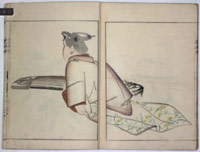
Click here to view image full size.
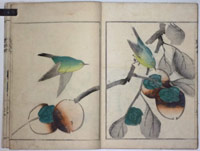
Click here to view image full size.
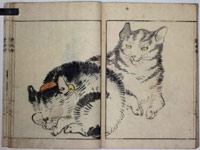
Click here to view image full size.
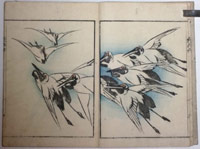
Click here to view image full size.
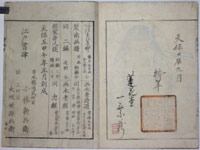
Click here to view image full size.
Ki BAITEI (1774-1810)
Click here to view image full size.
One volume complete: Kyuro gafu, “Kyuro’s Picture Album.” ( Kyuro was one of the art-names of Baitei, a Nanga painter in the Buson manner. ) The first edition of this book is in two volumes with haiku, c 1795. However, there is some confusion on the other issues: Mitchell, Biobibliography Of Nanga, Maruyama, Shijo Illustrated Books, pages 402-4, lists three examples: “A” ( 2 vol. 1795 ); “B” ( 2 vol. 1799 ), and “C” ( 1 vol. 1797 ). The example offered here does not tally with either of these having preface of 2 pp. with 64 single-page illustrations plus 2 pp. afterward and colophon dated Kansai 11 ( 1799 ) published by Koto Shorin. There are also examples with 62 pp. of illustrations and some lacking forward and or afterward and colophon. A later edition of 1824 is also known. A famous book with impressive, bold and austere images.
Lacking original covers and title slip and with some offsetting, but generally a nice copy. Ex Bing collection. In chitsu.
Status: Sold
Katsushika HOKUSAI (1760-1849)
Click here to view image full size.
Three volumes complete: Ehon kyoka yama-mata-yama, “Kyoka: Range Upon Range of Mountains.” The fanciful title is based on the fact that the views illustrated are located around Yama-no-te, the higher ground situated in the north and north-western part of Edo. The pictures accompanied by kyoka poems. Vol.1: 12 sheets, 11 illus.; Vol.2: 10 sheets, 11 illus.; Vol.3, 10 sheets, 10 illus. Kyoka selected by Daigentei Sumikata and Benbenkwan Koryu. This is one of Hokusai’s most admired works. Published 1804 by Tsutaya Jusaburo.
Original dark green embossed covers. Original title slips. A very nice clean copy of this famous book. Some slight smudging of pigments and turning of colour on one or two sheets, but otherwise extremely well retained colour, the elusive blue and purple intact.
Status: Sold
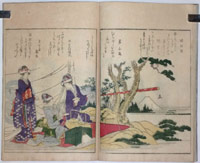
Click here to view image full size.
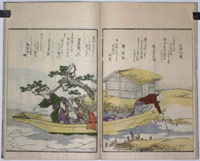
Click here to view image full size.
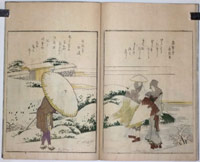
Click here to view image full size.
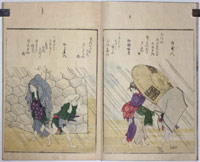
Click here to view image full size.
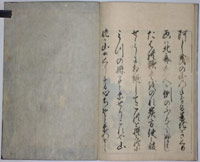
Click here to view image full size.
Aikawa MINWA (? – 1821)
Click here to view image full size.
Korin gashiki, “Drawing Methods of Korin.” One volume complete. Original orange-brown covers with original title slip. Preface dated Bunka 15 ( 1818 ) with 56 pp. of illustrations in light colour. Booksellers: Tsurugaya Kihei ( Osaka ); Kikuya Shichirobei and Kikuya Kihei ( Kyoto ). Ex collections Ulrich Odin, seal bottom right first page ( lot 126, Paris, 1928, ill. pl.V, and Javal ( ref: brocade covered boards ).
Very good impressions. Minor marks with ink smudge on one sheet and two paper repairs on another, otherwise good condition.
Status: Sold
Onishi CHINNEN (1792-1851)
Click here to view image full size.
A highly talented artist, he is considered – with Nanrei – to be the finest exponent of the Maruyama-Shijo style in Edo at this time. Of samurai birth, he initially studied under Nangaku and is famous for the highly regarded books: Azuma no teburi, 1829 and Sonan gafu, 1834 ( offered elsewhere on this site ). Shows Fuji looming above masts and a bridge. Possibly the Inari Bridge near the harbour ( shrine ) at Teppozu in Edo. See Hiroshige’s design of this view for the 100 Views of Edo, no. 77. A typically spontaneous Shijo painting. Sumi on paper. Image size 41 x 10.5 in; 105 x 27 cms. Blue paper mounting; grey-blue damask ichimonji with bamboo rollers. Light creasing otherwise good condition with box. Signed Chinnen with seal Unka.
Status: Sold
Onishi CHINNEN (1792-1851)
Click here to view image full size.
A highly talented artist, he is considered – with Nanrei – to be the finest exponent of the Maruyama-Shijo style in Edo at this time. Of samurai birth, he initially studied under Nangaku and is famous for the highly regarded books: Azuma no teburi, 1829 and Sonan gafu, 1834 ( offered elsewhere on this site ). Shows a carp climbing a waterfall. A leaping carp is one of the commonest subjects for artists of various schools so as to become almost hackneyed. It takes an individual artist to breath life into the subject. Sumi and very light colour on silk. Image size 39.5 x 19 in; 99.5 x 35.5 cms. Blue-grey damask and beige silk mounting; cream gold damask ichimonji with bone jiku. New box. Light toning otherwise very good condition with splashed gofun around the head of the fish. Signed Chinnen with seal Unka.
Status: Sold
Hirano HAKUHO (1879-1957)
Click here to view image full size.
Wakai onna, Young Girl, published by Watanabe Shozaburo, c. 1936. Illustrated in The Female Image, Abe Publishing Ltd., 2000, no. 211, p. 154.
Fine impression and colour. Minor crease bottom right corner, otherwise very good condition. Signed Hakuho ga.
Status: Sold
Utagawa KUNIYOSHI (1797-1861)
Click here to view image full size.
An unfinished otanzaku set Buyu nazorae Genji, “Selected Warriors for the Chapters of Genji.” This design illustrating Chapter 38 ( Suzumushi ) of the Genji monogatari ( the Genji crest in the middle upper right cartouche ). Shows Satsuma Taira Tadanori in court dress with open fan at the door of the house of Kiku-no-mae of the Miyabara family. Published by Ibaya Sensaburo, c 1846. Robinson S28.38.
Fine impression, colour and condition. A slightly later and trimmed copy illustrated in Heroes & Ghosts, 1998, no. 44, p. 70. Signed Ichiyusai Kuniyoshi ga.
Status: Sold
Utagawa HIROSHIGE (1787-1858)
Click here to view image full size.
Hirame, olive halibut ( Paralichthys olivaceus ) and mebaru, black rock-fish ( Sebastes schlegeli ). Together with cherry blossom. Poem by Osaki Koharu. From the second series of nine fish prints published c 1840 – 42 by Yamasho ( Yamadoya Shobei ). Ex collection Felix Bracquemond ( 1833 – 1914 ). Japonisme in France usually starts with Bracquemond who was a graphic artist and designer and also worked with ceramics. He discovered Hokusai’s Manga in 1856 and used it as source material. He produced a number of etchings, often of birds and some with fish, obviously partly inspired by Japanese prints, including Hiroshige’s prints. So, it’s reasonable to suppose these were the actual prints he used as inspiration. Bracquemond’s initial: “B” accompanied the prints.
Very good impression, colour and condition. Centre fold as per usual. Signed Hiroshige ga.
Status: Sold
Utagawa HIROSHIGE (1787-1858)
Click here to view image full size.
Shimadai, a grouper ( probably Chilodactylus zonatus ) and ainame, greenling ( Hexagrammus otakii ). Together with red-berried nanten. Poem by Kanshunro Nushibito. From the second series of nine fish prints published c 1840 – 42 by Yamasho ( Yamadoya Shobei ). Ex collection Felix Bracquemond ( 1833 – 1914 ). Japonisme in France usually starts with Bracquemond who was a graphic artist and designer and also worked with ceramics. He discovered Hokusai’s Manga in 1856 and used it as source material. He produced a number of etchings, often of birds and some with fish, obviously partly inspired by Japanese prints, including Hiroshige’s prints. So, it’s reasonable to suppose these were the actual prints he used as inspiration. Bracquemond’s initial: “B” accompanied the prints.
Very good impression, colour and condition. Centre fold as per usual. Signed Hiroshige ga.
Status: Sold
Utagawa HIROSHIGE (1787-1858)
Click here to view image full size.
Akodai, the rock-fish. ( Sebastes matsubarae ). Known as the medetai, good-luck fish. Together with bamboo grass. Poem by Suzugaki. From the second series of nine fish prints published c 1840 – 42 by Yamasho ( Yamadoya Shobei ). Ex collection Felix Bracquemond ( 1833 – 1914 ). Japonisme in France usually starts with Bracquemond who was a graphic artist and designer and also worked with ceramics. He discovered Hokusai’s Manga in 1856 and used it as source material. He produced a number of etchings, often of birds and some with fish, obviously partly inspired by Japanese prints, including Hiroshige’s prints. So, it’s reasonable to suppose these were the actual prints he used as inspiration. Bracquemond’s initial: “B” accompanied the prints.
Very good impression, colour and condition. Centre fold as per usual. Signed Hiroshige hitsu.
Status: Sold
Utagawa HIROSHIGE (1787-1858)
Click here to view image full size.
Inada, yellowtail or amberjack ( Seriola quinqueradiata ) and fugu, blowfish or puffer ( Fugu pardalis ). Together with plum blossom. Poem by Suzugaki. From the second series of nine fish prints published c 1840 – 42 by Yamasho ( Yamadoya Shobei ). Ex collection Felix Bracquemond ( 1833 – 1914 ). Japonisme in France usually starts with Bracquemond who was a graphic artist and designer and also worked with ceramics. He discovered Hokusai’s Manga in 1856 and used it as source material. He produced a number of etchings, often of birds and some with fish, obviously partly inspired by Japanese prints, including Hiroshige’s prints. So, it’s reasonable to suppose these were the actual prints he used as inspiration. Bracquemond’s initial: “B” accompanied the prints.
Very good impression, colour and condition. Centre fold as per usual. Signed Hiroshige hitsu.
Status: Sold
Utagawa HIROSHIGE (1787-1858)
Click here to view image full size.
Suzuki, Japanese sea perch ( Lateolabrax japonicus ) and kaneme-tai, red bream ( possibly Beryx splendens ). With shiso or beefsteak plant. Poem by Atsugaki. From the second series of nine fish prints published c 1840 – 42 by Yamasho ( Yamadoya Shobei ). Ex collection Felix Bracquemond ( 1833 – 1914 ). Japonisme in France usually starts with Bracquemond who was a graphic artist and designer and also worked with ceramics. He discovered Hokusai’s Manga in 1856 and used it as source material. He produced a number of etchings, often of birds and some with fish, obviously partly inspired by Japanese prints, including Hiroshige’s prints. So, it’s reasonable to suppose these were the actual prints he used as inspiration. Bracquemond’s initial: “B” accompanied the prints.
Very good impression, colour and condition. Centre fold as per usual. Signed Hiroshige ga.
Status: Sold
Utagawa HIROSHIGE (1787-1858)
Click here to view image full size.
Katsuo, bonito ( Katsuwonus pelamis ). Also called ocean bonito, stripe-bellied bonito and striped tuna. Together with three sprigs of cherry ( sakura ). Poems by Toshinoto Haruki and Toshihiro Machikado. From the first series of eleven fish prints published c 1840 – 42 by Yamasho ( Yamadoya Shobei ). Ex collection Felix Bracquemond ( 1833 – 1914 ). Japonisme in France usually starts with Bracquemond who was a graphic artist and designer and also worked with ceramics. He discovered Hokusai’s Manga in 1856 and used it as source material. He produced a number of etchings, often of birds and some with fish, obviously partly inspired by Japanese prints, including Hiroshige’s prints. So, it’s reasonable to suppose these were the actual prints he used as inspiration. Bracquemond’s initial: “B” accompanied the prints.
Very good impression, colour and condition. Centre fold as per usual. Signed Hiroshige ga.
Status: Sold
Utagawa HIROSHIGE (1787-1858)
Click here to view image full size.
Tobiuo, flying fish ( probably Prognichthys ) and ishimochi also called guchi or shiroguchi, white croaker ( probably Argyrosomus argenatus ). Together with a single lily. Poem by Toshigaki Maharu. From the second series of nine fish prints published c 1840 – 42 by Yamasho ( Yamadoya Shobei ). Ex collection Felix Bracquemond ( 1833 – 1914 ). Japonisme in France usually starts with Bracquemond who was a graphic artist and designer and also worked with ceramics. He discovered Hokusai’s Manga in 1856 and used it as source material. He produced a number of etchings, often of birds and some with fish, obviously partly inspired by Japanese prints, including Hiroshige’s prints. So, it’s reasonable to suppose these were the actual prints he used as inspiration. Bracquemond’s initial: “B” accompanied the prints.
Very good impression, colour and condition. Centre fold as per usual. Signed Hiroshige ga.
Status: Sold
Utagawa HIROSHIGE (1787-1858)
Click here to view image full size.
Shiroamadai, white horsehead ( Latilus argentatus ) and omonhata, rock cod ( Epinephalus areolatus ). Together with Japanese horse radish, wasabi. Poem by Atsugaki. From the second series of nine fish prints published c 1840 – 42 by Yamasho ( Yamadoya Shobei ). Ex collection Felix Bracquemond ( 1833 – 1914 ). Japonisme in France usually starts with Bracquemond who was a graphic artist and designer and also worked with ceramics. He discovered Hokusai’s Manga in 1856 and used it as source material. He produced a number of etchings, often of birds and some with fish, obviously partly inspired by Japanese prints, including Hiroshige’s prints. So, it’s reasonable to suppose these were the actual prints he used as inspiration. Bracquemond’s initial: “B” accompanied the prints.
Very good impression, colour and condition. Centre fold as per usual. Signed Hiroshige hitsu.
Status: Sold
Toyohara KUNICHIKA (1835-1900)
Click here to view image full size.
An original hanshita-e drawing probably showing Benkei and Yoshitsune on Gojo Bridge. Sumi on thin paper, image size 14.5 x 6.25 in, 37 x 16 cms. For a series of designs contained within a hagoita ( wooden paddles used to play the New Year hanetsuki game ). Some creasing.
Status: Sold
Yamazaki TOSHINOBU (1857-1886)
Click here to view image full size.
The best design from Nihon ryakushi zu, “ A Brief History of Japan in Pictures.” Mongaku ( Endo Morito, c. 1120 – 1200 ) subjecting himself to three years penance as a Buddhist monk beneath the waterfall of Mount Nachi in Kii Province. Morito inflicted this punishment on himself because he had inadvertently cut off the head of Kesa Gozen, the wife of the palace guard Watanabe Wataru, with whom he was in love. This subject lends itself to some wonderful designs: See this website for a rare horizontal triptych by Yoshitoshi and a vertical triptych by Kuniyoshi, and there are many single sheets by various artists. Toshinobu was a pupil of Kunisada and then Yoshitoshi. Published by Kanei Heizaburo, 1878.
Very good impression color and condition. Signed Oju Toshinobu.
Status: Sold
Ichiyusai KUNIYOSHI (1797-1861)
Click here to view image full size.
The fifteen year old Otani Furuinosuke killing a wild boar with his bare hands. From the set Honcho Suikoden goyu happyaku-nin no hitori, “ Eight Hundred Heroes of Our Country’s Suikoden, One by One.” A series of fine designs coming after the Tsuzoku Suikoden that was a turning point in Kuniyoshi’s career. Robinson S4a.14. Published by Kaga-ya Kichiyemon, c early 1830s. Many designs from this set reissued by Ibaya Sensaburo, c 1845.
Very good impression. Fine colour and condition. Untrimmed ( a rarity on these designs ). Signed Ichiyusai Kuniyoshi ga.
Status: Sold
